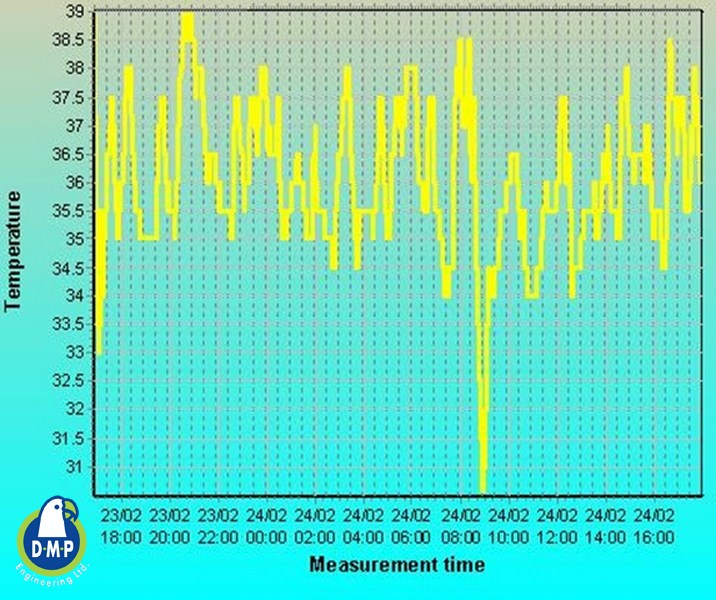It is Totally Different… (Temperature during Incubation)
After being a parrot breeder for many years, David Vishnia has decided to take a closer look at the incubating process in nature and to concentrate, for starters, on the Temperature issue.
“In all the professional books that I’ve read, all the experts say that each species has a different incubating temperature and the more accurate the temperature is – the better the hatching results should be”
To verify this bold statement, he used small-sized data loggers and hid them inside artificial eggs. Those eggs were then placed alongside genuine ones within the nesting box. The loggers were programmed to record temperature readings from inside the egg every 10 minutes. After a period of time, in which the eggs were under the brooding mother, David removed them downloaded the data from the loggers to his computer.
“Surprisingly, the data received from the loggers was not what I expected and painted a totally different picture. The temperature inside the again wasn’t fixed. In fact – it fluctuated between 35 Degrees Celsius and 39 Degrees Celsius and even higher – 40.5 Degrees Celsius… which makes sense because the brooding mother’s temperature is between 41- 42 Degrees Celsius. All the information, both from the nesting boxes in my aviaries and from birds in the wild showed the same results!
Furthermore, despite the differences in temperature, the hatching results were very good…
After thinking it over, the conclusions were inevitable: if this is what happens in nature, we should create the same conditions in artificial incubation!”
The next step in David’s research was to understand what caused this temperature fluctuation. He explains:
“at first, the brooding female warms the eggs’ upper part by touching it with her body and so it gets warmer than the egg’s lower part. In addition, she rolls the eggs with her beak, moving the warm eggs away and bringing the colder ones closer. All of this during an approximate cycle of an hour & a half. However, neither the temperature changes nor the length of the rolling cycle repeated itself accurately.”
The next step was checking the eggs:
“the experts say that the air pocket inside the egg enables the embryo to breath in the first minutes before the external PiP. It may be true but this is not the main reason. In my opinion, the air pocket allows expansions and contraction of the fluids inside. When the temperature goes up, expansion occurs and the air goes out from the air pocket. When the temperature goes down, a suction is created that allows oxygen to penetrate through the porous eggshell to the embryo.
We can describe this process as “breathing” and it contributes to the embryo’s proper development. A very accurate temperature will prevent the embryo from getting the desirable amount of oxygen it needs. This theory can be supported by candling the egg after 5 days. Then you see that the first blood vessels are attached to the eggshell in order to absorb oxygen for the embryo.

While checking chicken eggs’ embryos I found presence of blood vessels attached to the eggshell until the very last moment of hatching. The embryo’s body absorbed it until he could breath independently through the hole he “PiPed” in the eggshell. Obviously this “PiP” gets made in the air pocket where no blood vessels are present.
It is important to mention that while the embryo starts hatching the breeder can hear his twittering; These are not stress signs but an indication that the embryo has started to breath by its own. Any intervention at this stage could harm the blood vessels and cause the embryo’s death”.
The temperature’s changes are implemented in the Inca Incubators to guarantee that the embryo will receive enough oxygen to develop as best as possible. Moreover, because we replicate the natural incubating process as explained above, the chicks are stronger, more vivid and lively – and that brings an entirely different perspective to artificial incubation….
David Vishnia summarizes:
“to design a complicated and heavy incubator with many components is easy, but to design a simple, neat & light appliance that will give almost 100% hatching success rates is very hard and not always one can see the huge amount of work that was put into it…
I think that the following quotation from our testimonials’ letters will illustrates my idea:
During the use of your incubator, we have been deeply impressed by its sophisticated simplicity. One may think that simplicity and sophistication reflect opposite characteristics, but based on my life-long experience, I know that it take high level of sophistication to produce a product like your incubator, which is characterized by simplicity and reliability
Faculty of Agriculture
The Hebrew University of Jerusalem
April 2010


![egg4 [800x600]](http://www.dmp-engineering.com/wp-content/uploads/2012/01/egg4-800x600.jpg)

Pingback: Does the embryo need help hatching? | D.M.P. Engineering Ltd.()
Pingback: Cialis()
Pingback: buy viagra()
Pingback: Viagra Discount()
Pingback: Buy Clonazepam()
Pingback: viagra()
Pingback: Zolpidem()
Pingback: furacin 2mg()
Pingback: buy viagra online()
Pingback: Meridia()
Pingback: Cheap Cialis()
Pingback: Buy Phentermine()
Pingback: xbox 360()